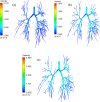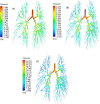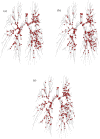SARS CoV-2 aerosol: How far it can travel to the lower airways?
- PMID: 34149275
- PMCID: PMC8210163
- DOI: 10.1063/5.0053351
SARS CoV-2 aerosol: How far it can travel to the lower airways?
Abstract
The recent outbreak of the SARS CoV-2 virus has had a significant effect on human respiratory health around the world. The contagious disease infected a large proportion of the world population, resulting in long-term health issues and an excessive mortality rate. The SARS CoV-2 virus can spread as small aerosols and enters the respiratory systems through the oral (nose or mouth) airway. The SARS CoV-2 particle transport to the mouth-throat and upper airways is analyzed by the available literature. Due to the tiny size, the virus can travel to the terminal airways of the respiratory system and form a severe health hazard. There is a gap in the understanding of the SARS CoV-2 particle transport to the terminal airways. The present study investigated the SARS CoV-2 virus particle transport and deposition to the terminal airways in a complex 17-generation lung model. This first-ever study demonstrates how far SARS CoV-2 particles can travel in the respiratory system. ANSYS Fluent solver was used to simulate the virus particle transport during sleep and light and heavy activity conditions. Numerical results demonstrate that a higher percentage of the virus particles are trapped at the upper airways when sleeping and in a light activity condition. More virus particles have lung contact in the right lung than the left lung. A comprehensive lobe specific deposition and deposition concentration study was performed. The results of this study provide a precise knowledge of the SARs CoV-2 particle transport to the lower branches and could help the lung health risk assessment system.
© 2021 Author(s).
Figures










Similar articles
-
Deposition distribution of the new coronavirus (SARS-CoV-2) in the human airways upon exposure to cough-generated droplets and aerosol particles.Sci Rep. 2020 Dec 31;10(1):22430. doi: 10.1038/s41598-020-79985-6. Sci Rep. 2020. PMID: 33384436 Free PMC article.
-
How severe acute respiratory syndrome coronavirus-2 aerosol propagates through the age-specific upper airways.Phys Fluids (1994). 2021 Aug;33(8):081911. doi: 10.1063/5.0061627. Epub 2021 Aug 19. Phys Fluids (1994). 2021. PMID: 34552312 Free PMC article.
-
Helium-Oxygen Mixture Model for Particle Transport in CT-Based Upper Airways.Int J Environ Res Public Health. 2020 May 20;17(10):3574. doi: 10.3390/ijerph17103574. Int J Environ Res Public Health. 2020. PMID: 32443715 Free PMC article.
-
Minimum Sizes of Respiratory Particles Carrying SARS-CoV-2 and the Possibility of Aerosol Generation.Int J Environ Res Public Health. 2020 Sep 23;17(19):6960. doi: 10.3390/ijerph17196960. Int J Environ Res Public Health. 2020. PMID: 32977575 Free PMC article. Review.
-
The role of the oral cavity in SARS-CoV-2- and other viral infections.Clin Oral Investig. 2023 Jun;27(Suppl 1):15-22. doi: 10.1007/s00784-023-05078-z. Epub 2023 Jun 13. Clin Oral Investig. 2023. PMID: 37310513 Free PMC article. Review.
Cited by
-
Reducing Virus Transmission from Heating, Ventilation, and Air Conditioning Systems of Urban Subways.Toxics. 2022 Dec 17;10(12):796. doi: 10.3390/toxics10120796. Toxics. 2022. PMID: 36548629 Free PMC article.
-
Aerosol Dynamics in the Respiratory Tract of Food-Producing Animals: An Insight into Transmission Patterns and Deposition Distribution.Animals (Basel). 2025 May 12;15(10):1396. doi: 10.3390/ani15101396. Animals (Basel). 2025. PMID: 40427273 Free PMC article.
-
Heat Wave and Bushfire Meteorology in New South Wales, Australia: Air Quality and Health Impacts.Int J Environ Res Public Health. 2022 Aug 20;19(16):10388. doi: 10.3390/ijerph191610388. Int J Environ Res Public Health. 2022. PMID: 36012020 Free PMC article.
-
Is the SARS CoV-2 Omicron Variant Deadlier and More Transmissible Than Delta Variant?Int J Environ Res Public Health. 2022 Apr 11;19(8):4586. doi: 10.3390/ijerph19084586. Int J Environ Res Public Health. 2022. PMID: 35457468 Free PMC article. Review.
-
On-site airborne pathogen detection for infection risk mitigation.Chem Soc Rev. 2023 Dec 11;52(24):8531-8579. doi: 10.1039/d3cs00417a. Chem Soc Rev. 2023. PMID: 37882143 Free PMC article. Review.
References
-
- Anderson, P. J. , “ History of aerosol therapy: Liquid nebulization to MDIs to DPIs,” Respir. Care 50(9), 1139–1150 (2005). - PubMed
-
- Atkinson, J. , Chartier, Y. , Pessoa-Silva, C. L. , Jensen, P. , Li, Y. , and Seto, W. , “ Annex C: Respiratory droplets,” in Natural Ventilation for Infection Control in Health-Care Settings ( World Health Organization, 2009). - PubMed
LinkOut - more resources
Full Text Sources
Miscellaneous
